Abstract
We validated a survey tool to test the readiness of oral health professionals for teledentistry (TD). The survey tool, the University of Calgary Health Telematics Unit’s Practitioner Readiness Assessment Tool (PRAT) gathered information about the participants’ beliefs, attitudes and readiness for TD before and after a teledentistry training program developed for a rural state in the Mid-Western United States. Ninety-three dental students, oral health and other health professionals participated in the TD training program and responded to the survey. Wilcoxon signed rank test was used to assess statistical differences in the change in the readiness rating before and after the training. Principal Components Analysis identified a three factor structure for the PRAT tool: Attitudes/ Attributes of Personnel; Motivation to Change and Institutional Resources. Overall, the evaluation demonstrated a positive change in all trainees’ attitudes following the training sessions, with the majority of trainees acknowledging a positive impact of the training on their readiness for teledentistry.
Similar content being viewed by others
References
Bauer, J. C., and Brown, W. T., The digital transformation of oral health care: teledentistry and electronic commerce. J. Am. Dent. Assoc. 132(2):204–209, 2001.
Sanchez Dils, E., Lefebvre, C., and Abeyta, K., Teledentistry in the United States: a new horizon of dental care. Int. J. Dent. Hyg. 2(4):161–164, 2004.
Glassman, P., Helgeson, M., and Kattlove, J., Using telehealth technologies to improve oral health for vulnerable and underserved populations. J. Calif. Dent. Assoc. 40(7):579–585, 2012.
Cook, J., Edwards, J., Mullings, C., et al., Dentists' opinions of an online orthodontic advice service. J. Telemed. Telecare 7(6):334–337, 2001.
Mandall, N., Quereshi, U., and Harvey, L., Teledentistry for screening new patient orthodontic referrals. part 2: GDP perception of the referral system. Br. Dent. J. 199(11):727–729, 2005.
Flores-Mir, C., Palmer, N. G., Northcott, H. C., et al., Perceptions and attitudes of Canadian dentists toward digital and electronic technologies. J. Can. Dent. Assoc. 72(3):243, 2006.
Jathanna, V. R., Jathanna, R. V., and Jathanna, R., The awareness and attitudes of students of one Indian dental school toward information technology and its use to improve patient care. Educ. Health (Abingdon) 27(3):293–296, 2014.
Nagarajappa, R., Aapaliya, P., Sharda, A. J., et al., Teledentistry: knowledge and attitudes among dentists in Udaipur, India. Oral Health Dent. Manag. 12(502):2, 2013.
Ignatius, E., and Mäkelä, K., Use and attitudes towards teleconsultation in dentistry. E-Health Telecommun. Syst. Netw. 2(01):9, 2013.
Information Technology by Iranian Dentists, Assessment of knowledge and performance. J. Islamic Dent. Assoc. IRAN (JIDAI) 26(1):1, 2014.
University of Florida College of Dentistry Needs Assessment: Teledentistry-December 2004. (personal communication).
Jennett, P., Jackson, A., Healy, T., et al., A study of a rural community's readiness for telehealth. J. Telemed. Telecare 9(5):259–263, 2003.
Southwest Telehealth Resource Center. Form templates: Sample site assessment documents: Initial Site Assessment Tool. http://southwesttrc.org/sites/southwesttrc.org/files/files/Telemedicineassessmentdocum.pdf (Accessed 11 July, 2015).
Stephens, C. D., and Cook, J., Attitudes of UK consultants to teledentistry as a means of providing orthodontic advice to dental practitioners and their patients. J. Orthod. 29:137–42, 2002.
Daniel, S. J., and Kumar, S., Teledentistry: a key component in access to care. J. Evid. Based Dent. Pract. 14:201–208, 2014.
Palmer, N. G., Yacyshyn, J. R., Northcott, H. C., et al., Perceptions and attitudes of Canadian orthodontists regarding digital and electronic technology. Am. J. Orthod. Dentofacial Orthop. 128(2):163–167, 2005.
Legare, E., Vincent, C., Lehoux, P., et al., Telehealth readiness assessment tools. J. Telemed. Telecare 16(3):107–109, 2010.
Snyder-Halpern, R., Indicators of organizational readiness for clinical information technology/systems innovation: a Delphi study. Int. J. Med. Inf. 63(3):179–204, 2001.
Khoja, S., Scott, R. E., Casebeer, A. L., et al., e-Health readiness assessment tools for healthcare institutions in developing countries. Telemed. e-Health 13(4):425–432, 2007.
Parasuraman, A., Technology Readiness Index (TRI) a multiple-item scale to measure readiness to embrace new technologies. J. Serv. Res. 2(4):307–320, 2000.
Lin, J. C., and Hsieh, P., The influence of technology readiness on satisfaction and behavioral intentions toward self-service technologies. Comput. Hum. Behav. 23(3):1597–1615, 2007.
Lehman, W. E., Greener, J. M., and Simpson, D. D., Assessing organizational readiness for change. J. Subst. Abuse Treat. 22(4):197–209, 2002.
Author information
Authors and Affiliations
Corresponding author
Ethics declarations
Funding Source
This publication was made possible by Grant # D85HP20046 from the Health Resources and Services Administration (HRSA). Its contents are solely the responsibility of the authors and do not necessarily represent the official views of the HRSA, Bureau of Health Workforce or the Department of Health and Human Services.
Conflicts of Interest
All the Authors declare that there are no conflicts of interest.
Ethical Approval
All procedures performed in studies involving human participants were in accordance with the ethical standards of the institutional research committee and with the 1964 Helsinki declaration and its later amendments or comparable ethical standards.
Informed Consent
Informed verbal consent was obtained from all individual participants included in the study.
Additional information
This article is part of the Topical Collection on Education and Training.
Rights and permissions
About this article
Cite this article
Nayar, P., McFarland, K.K., Chandak, A. et al. Readiness for Teledentistry: Validation of a Tool for Oral Health Professionals. J Med Syst 41, 4 (2017). https://doi.org/10.1007/s10916-016-0654-7
Received:
Accepted:
Published:
DOI: https://doi.org/10.1007/s10916-016-0654-7




